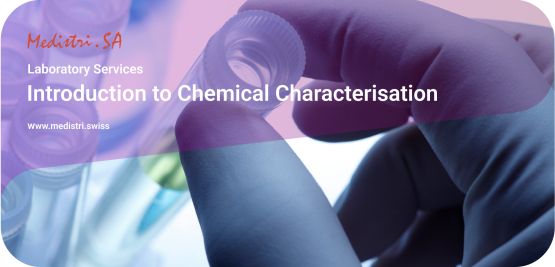(Download: Introduction to Chemical Characterisation in PDF by Medistri)
The chemical characterization of materials is an essential aspect of the regulatory review and approval of medical devices in the European Union (EU) and most major markets worldwide. Chemical characterization is also an essential aspect of the overall biocompatibility assessment process, which helps to ensure that the potential benefits of using a given medical device are not outweighed by the potential biological risks associated with that device or its components or materials.
Chemical Characterization involves the identification of a material and the identification and quantification of its chemical constituents as part of an assessment of the overall biological safety of a medical device. It also involves a measurement of the level of a leachable substance (traces of chemicals originating from raw materials and fabrication processes that may result in exposure to patients) in a medical device in order to:
- Allow the assessment of compliance with the allowable limit derived for that substance from health based risk assessment
- Determine equivalence of a proposed material to another material or to another final device / prototype
- For screening of potential new materials for suitability in a medical device for a proposed clinical application.
According to ISO 10993-18:2005, chemical characterization is the process of obtaining chemical information by data gathering and complementary generation (interaction between two different genes that work together to create a specific phenotype or visible trait that isn’t possible if they are separated), for example, by chemical testing. More precisely, it entails the use of analytical chemistry to identify and qualify the amount of chemicals extracted from a device.
Chemical characterization is used to identify and quantify chemical substances found in medical devices or materials that may contribute to the toxicological and biological risk management for the device - the objective of this analytical analysis is to identify and quantify the soluble and insoluble elements that will potentially be released from the Medical Device.
It supports the biological evaluation, since it provides an understanding of the intrinsic properties of the medical device. This way, it is possible to establish which endpoints require further investigation through biological testing. With this approach, unnecessary testing may be avoided, especially the long-term ones (as carcinogenicity, gennotoxicity or chronic toxicity) if there’s a scientific rationale to support the use of previously collected information.
There are two categories of tests to perform a chemical characterization: direct material characterization and evaluation of substances potentially released by the devices.
👉 The first group of tests evaluates the inner chemical properties of materials. The latter assesses those substances that can leach out from a device by conducting an extractable and leachable analysis followed by toxicological risk evaluation based on the tolerable exposure levels. This data should then be evaluated by a group of experts that examine each compound, using existing literature and tools established in ISO 19003-17:2022.
According to ISO 10993, the international standard for establishing a device’s biocompatability, extractables are “substances that can be released from a medical device or material using extraction solvents and/ or extraction conditions that are expected to be at least as aggressive as the conditions of clinical use.”
Chemical Characterization is defined by the ISO-10993-18 standards. In order to test the biocompatibility of your medical device, qualitative and quantitative data must be collected on the materials that make up the devices in the context of biological safety. In the absence of such information, the material should be tested using appropriate techniques to collect data on its composition and its potential extractibles.
The ISO 10993-18 standard tests must be performed when developing a new medical device, when changing the manufacturing process or when changing materials and/or suppliers. Please be aware that even if a material has been historically shown to be biocompatible, it must still pass the ISO 10993-18 tests:
👉 Simulated extraction : An extraction with simulated use is performed to estimate the type and quantity of substances expected to be released from a medical device during its clinical use.
👉 Exaggerated Extraction : Extraction intended to result in the release of a larger number or quantity of chemical constituents than would be produced under clinical conditions of use.
👉 Exhaustive Extraction : Multi-stage extraction performed so that the amount of extracted material recovered in a later step is less than 10% of that detected, by gravimetric analysis (or by any other means), in the initial extraction step.
Information on the chemical composition of medical devices and materials intended to come into direct or indirect contact with a patient must be provided to obtain regulatory approval in North America , Europe and other important target markets like Greater China, Japan, Korea and Singapore, as part of the biocompatibility assessment process.
Conducting a consistent chemical characterization with the requirements of ISO 10993-18 is a critical aspect of a manufacturer’s overall effort to verify the safety of their medical devices. A thorough evaluation of the chemical safety of device components and materials can increase the likelihood of a smooth and efficient regulatory review process.
Medistri’s in-house laboratory possesses an in-depth comprehension of the Chemical Characterisation execution process to meet your regulatory requirements.
🎯 To learn more about Medistri’s Chemical Characterisation services, visit on our website at www.medistri.swiss or directly contact our team at contact@medistri.swiss.
- The Medistri Team
#Medistri
